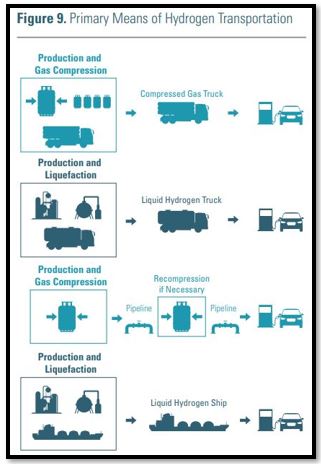DISTRIBUTION
HOW CAN HYDROGEN BE TRANSPORTED AND DISPENSED?
For hydrogen to be a viable transportation fuel, it has to be available to fuel vehicles. . Depending on the hydrogen feedstock and related hydrogen production process, hydrogen fuel can either be created at or near the site of use, or centrally produced and distributed to fueling stations.
Making hydrogen fuel available at thousands of future fueling stations presents many challenges. While building a new hydrogen pipeline network involves high initial capital costs, producing hydrogen transportation fuel at the point of end-use carries the cost of multiple production facilities rather than a few large centralized plants.[1] Investments in either strategy require the widespread adoption of fuel cell electric vehicles.
Currently, hydrogen is distributed through three methods:
- Pipeline: This is the least-expensive way to deliver large volumes of hydrogen, but currently there are only about 1,600 miles of U.S. pipelines for hydrogen. Building a new hydrogen pipeline network will involve high initial capital costs, and hydrogen's properties present unique challenges to pipeline materials and compressor design.[2]
- High-Pressure Tube Trailers: Transporting compressed hydrogen gas by truck, railcar, ship, or barge in high-pressure tube trailers is used primarily for distances under 200 miles, due to the high cost.[3]
- Liquefied Hydrogen Tankers: Cryogenic liquefaction is a process that cools the hydrogen to a temperature where it becomes a liquid – which is expensive – but this process enables hydrogen to be transported more efficiently than high-pressure tube trailers when covering longer distances by truck, railcar, ship, or barge. However, if the liquefied hydrogen is not used at a sufficiently high rate at the site of consumption, it evaporates from its containment vessels, so the delivery and consumption rates must be carefully matched.[4]
Source: Department of Energy, July 2020[5]
Key challenges to hydrogen delivery include reducing cost, increasing energy efficiency, maintaining hydrogen purity, and minimizing hydrogen leakage. Building a national hydrogen delivery infrastructure will take time to develop and will likely include combinations of these methods – as needs will vary by region and type of market—for example, urban, interstate, or rural. Options will evolve as the technologies develop and improve and the demand for hydrogen grows.[6]
For more on hydrogen delivery, on-site storage, and dispensing technologies, visit the following DOE links:
- Gaseous hydrogen
- Liquid hydrogen
- Novel hydrogen carriers
- On-site and bulk storage
- Dispensing hydrogen fuel to vehicles
Updated June 2022 by Erin Bennett


Comments are closed.